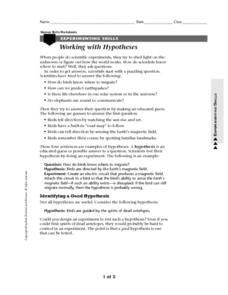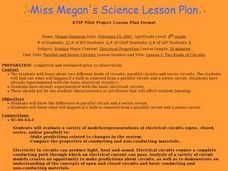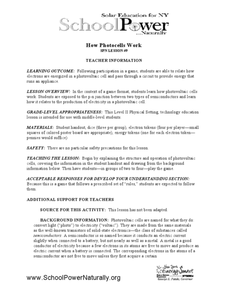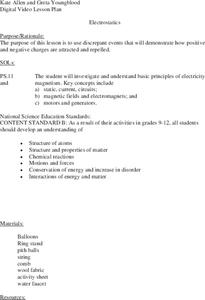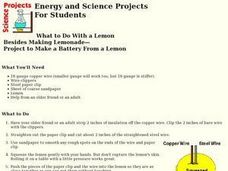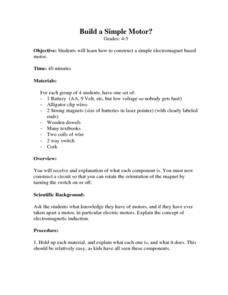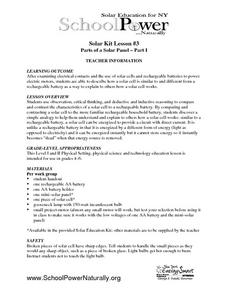Curated OER
Working With Hypotheses
In this science worksheet, learners examine the topic in order to solidify knowledge covered in the curriculum using puzzles and creative games.
Curated OER
Two Kinds of Circuits
Fourth graders examine parallel and series ciruits. They experiment what happens if a bulb is removed from both a parallel and series circuit. They understand the differences between parallel and series ciruits,
Curated OER
TE Activity: Ohm's Law 2
High schoolers study Ohm's Law 2 after completing an activity about Ohm's Law 1. They determine how long it takes to charge a battery. They examine if it is better to use batteries in series or parallel circuits.
Curated OER
Castaway or Survivor
What a clever idea! Chemistry learners imagine themselves deserted on an island with a radio, but no batteries. They also have a few odds and ends in their pockets and storage chest. They are challenged to create a battery that will...
Curated OER
How Photocells Work
Give small groups of physical scientists tokens that represent electrons in a photovoltaic cell. They play a dice game in which they move the tokens around, representing the flow of electrons through the p-n junction of a semiconductor...
Curated OER
Electrostatics
Middle schoolers examine ways positive and negative charges are attracted and repelled by watching teacher demonstrations, and complete activity sheet related to classroom demonstration activities to prove proficiency of knowledge of...
Curated OER
Pickle Juice
Students generate experimental questions regarding conductors of electricity, plug cord into pickle, and measure and graph voltage drop across electrodes. Students then compare to variety of other conductors of their choosing.
Curated OER
Scouting for Circuits
Fifth graders investigate electricity and how it used in a circuit to be useful energy. They also use this investigation in order to understand how energy can change forms and still be considered useful if put into the right form.
Curated OER
Dimmer and Dimmer and Dimmer and Dimmer
Eighth graders model rheostats to see how they work.
NASA
Photons in the Radiative Zone: Which Way Is Out? An A-Maz-ing Model
Can you move like a photon? Young scholars use a maze to reproduce the straight line motion of a photon. The second in a six-part series of lessons on the sun has learners measure angle of incidence and refraction to determine the path...
Curated OER
Light Your Way
Students investigate how a simple series circuit functions. They design and construct a working portable flashlight, develop a written plan for the flashlight, test their flashlight for functionality and reliability, and draw the series...
Curated OER
Safety Grounding
In this grounding worksheet, students answer 12 questions about electrical power systems, the importance of grounding and electric shock.
Curated OER
Semiconductors
Students investigate the properites of a semiconductor device known as a diode. They recognize a diode as a one way conducting device. They describe alternating current and the use of a diode to convert it to direct current. Students...
Curated OER
Design Project: Intercom System
In this electrical worksheet students design an intercom circuit and answer 2 open-ended questions about the volume control and microphone of the intercom. This worksheet can be printed and the answers to the questions are available...
Curated OER
Discovering Ohm's Law
Students explore the relationship of resistance, voltage, and current in series and parallel circuits using a computer model of a circuit board. They discover Ohm's Law by constructing series circuits.
Curated OER
Insulators and Conductors
Students conduct an experiment in which they create open and closed circuits. For this insulators and conductors lesson, students review open and closed circuits and then get in groups to make both kinds of circuit. ...
Curated OER
Stepper Motor
Students compare a stepper motor from a traditional motor. In this physics instructional activity, students summarize how it works. They build their own stepper motor and explore its uses.
Curated OER
Electronic Components
Students review new terminology and computer circuits and the value of a resistor. They complete three experiments, "Resistance Activities," Transistor Activities,"Diode Activities" and enter data, results and their findings on Student...
Curated OER
What's Wrong With Nuclear Power, Anyway?
Students see that the production and use of nuclear energy has been both praised and condemned as a source of electrical power for our daily living. They examine the reasons for the conflict of opinions in our society.
Curated OER
Make a Battery From a Lemon
Fifth graders construct a voltaic battery. They change chemical energy into electrical energy by inserting copper wire into a lemon. They discover the tingle of the wire on their tongue is due to the movement of electrons.
Curated OER
Build a Simple Motor?
Students experience how to construct a simple electromagnet based motor. In groups they explore what a component is and construct a circuit that can rotate the orientation of the magnet by turning the switch on and off. Electromagnetic...
Curated OER
Parts of a Solar Panel-Part I
Learners examine electrical contacts, solar cells, and rechargeable batteries and compare and contrast the characteristics of a solar cell to a rechargeable battery in a hands-on activity. Students complete a worksheet as they...
Curated OER
Forces in Action
Students investigate questions centered around force and motion by going through the scientific process and creating fair tests and experimentation. In this lesson about forces-in-action, students diagram their findings and explore other...
Curated OER
Basic Ohmmeter Use
In this ohmmeter activity, students are given ten questions about circuits and and the resistance in those circuits. They explain how an ohmmeter is used and answer questions about different wire systems and their resistance.
